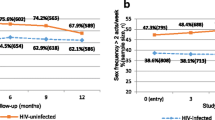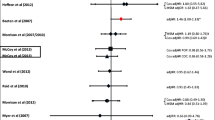Abstract
Contraceptive preferences of women at risk for HIV acquisition are not well documented. We report on contraceptive choices among women residing in small townships in southwestern Uganda. This was part of preparatory efforts for recruitment into the Ring Study, a phase 3 microbicide trial, between July 2013 and October 2014. Clinicians provided contraceptives per a woman’s choice. HIV testing and screening for other sexually transmitted infections were done at first contact and at screening for the trial. Contraceptive choice was summarized by demographics and regression analysis to show factors associated with use of the injectable method. Of 6725 women contacted, 489 were prescreened. Of these 489 women, most (306, 63%) were already using contraception. Injectables were most preferred (58.7%), followed by implants (23.9%). Women living with a regular sexual partner preferred the injectable method (61.0%, P = 0.06), compared with other methods. Women at risk for HIV infection are willing to initiate use of modern contraceptives, which may reduce study dropout during intervention trials due to unintended pregnancy. Registration no: NCT01539226.

Similar content being viewed by others
References
Hubacher D, Mavranezouli I, McGinn E. Unintended pregnancy in sub-Saharan Africa: magnitude of the problem and potential role of contraceptive implants to alleviate it. Contraception. 2008;78(1):73–8.
Singh S, Moore A, Bankole A, Mirembe F, Wulf D. Unintended pregnancy and induced abortion in Uganda: causes and consequences. New York: Guttmacher Institute; 2006.
Statistics UBo. Uganda Demographic and Health Survey: Key Indicators Report. Directorate of Population and Social Statistics, Uganda Bureau of Statistics; 2016.
Scorgie F, Nakato D, Harper E, et al. ‘We are despised in the hospitals’: sex workers’ experiences of accessing health care in four African countries. Cult Health Sex. 2013;15(4):450–65.
Kaida A, Laher F, Strathdee SA, et al. Contraceptive use and method preference among women in Soweto, South Africa: the influence of expanding access to HIV care and treatment services. PLoS ONE. 2010;5(11):e13868.
Karim QA, Karim SSA, Frohlich JA, et al. Effectiveness and safety of tenofovir gel, an antiretroviral microbicide, for the prevention of HIV infection in women. Science. 2010;329(5996):1168–74.
Abaasa A, Gafos M, Anywaine Z, et al. Uptake of hormonal contraceptives and correlates of uptake in a phase III clinical trial in rural South Western Uganda. Reprod Health. 2017;14(1):36.
Reid SE, Dai JY, Wang J, et al. Pregnancy, contraceptive use, and HIV acquisition in HPTN 039: relevance for HIV prevention trials among African women. J Acquir Immune Defic Syndr. 2010;53(5):606.
UNAIDS guidance note on HIV and sex work; 2009. http://www.unaids.org/en/media/unaids/. Accessed 22 August 2016.
Decker MR, Yam EA, Wirtz AL, et al. Induced abortion, contraceptive use, and dual protection among female sex workers in Moscow, Russia. Int J Gynecol Obstet. 2013;120(1):27–31.
Delvaux T, Crabbe F, Seng S, Laga M. The need for family planning and safe abortion services among women sex workers seeking STI care in Cambodia. Reprod Health Matters. 2003;11(21):88–95.
Erickson M, Goldenberg SM, Ajok M, Muldoon KA, Muzaaya G, Shannon K. Structural determinants of dual contraceptive use among female sex workers in Gulu, northern Uganda. Int J Gynecol Obstet. 2015;131(1):91–5.
Stephenson R, Baschieri A, Clements S, Hennink M, Madise N. Contextual influences on modern contraceptive use in sub-Saharan Africa. Am J Public Health. 2007;97(7):1233.
Emina JB, Chirwa T, Kandala N-B. Trend in the use of modern contraception in sub-Saharan Africa: does women’s education matter? Contraception. 2014;90(2):154–61.
Callahan R, Nanda K, Kapiga S, et al. Pregnancy and contraceptive use among women participating in the FEM-PrEP trial. JAIDS J Acquir Immune Defic Syndr. 2015;68(2):196–203.
Akello CA, Bunge KE, Nakabiito C, et al. Contraceptive use and pregnancy incidence among women participating in an HIV prevention trial. J Womens Health. 2017;26(6):670–6.
Sibeko S, Baxter C, Yende N, Karim QA, Karim SSA. Contraceptive choices, pregnancy rates, and outcomes in a microbicide trial. Obstet Gynecol. 2011;118(4):895.
Delvaux T, Buve A. Hormonal contraception and HIV acquisition—what is the evidence? What are the policy and operational implications? Eur J Contracept Reprod Health Care. 2013;18(1):15–26.
Morrison CS, Chen P-L, Kwok C, et al. Hormonal contraception and the risk of HIV acquisition: an individual participant data meta-analysis. PLoS Med. 2015;12(1):e1001778.
Morrison CS, Pai-Lien C, Cynthia K, et al. Hormonal contraception and HIV acquisition: reanalysis using marginal structural modeling. AIDS (London, England). 2010;24(11):1778.
Nel A, van Niekerk N, Kapiga S, et al. Safety and efficacy of a dapivirine vaginal ring for HIV prevention in women. N Engl J Med. 2016;375(22):2133–43.
Health Mo. Uganda national guidelines for the syndromic management of sexually transmitted infections. STD Control Unit of the STD/AIDS Control programme. Ministry of Health, Uganda; 2010.
Centers for disease control and prevention. sexually transmitted diseases treatment guidelines. In: Services UDoHaH, editor. Office of surveillance, epidemiology, and laboratory services, centers for disease control and prevention (CDC), U.S. Department of Health and Human Services, MMWR 2010;59. No. RR-12.
Skove T, Deddens J, Petersen MR, Endahl L. Prevalence proportion ratios: estimation and hypothesis testing. Int J Epidemiol. 1998;27(1):91–5.
Royston P, Ambler G, Sauerbrei W. The use of fractional polynomials to model continuous risk variables in epidemiology. Int J Epidemiol. 1999;28(5):964–74.
Sutherland EG, Otterness C, Janowitz B. What happens to contraceptive use after injectables are introduced? An analysis of 13 countries. Int Perspect Sex Reprod Health. 2011;37(4):202–8.
United Nations. World Contraceptive Patterns. In: Affairs DoEaS, Division P, editors. New York: United Nations; 2013.
Polis CB, Curtis KM, Hannaford PC, et al. An updated systematic review of epidemiological evidence on hormonal contraceptive methods and HIV acquisition in women. AIDS (London, England). 2016;30(17):2665.
Polis CB, Phillips SJ, Curtis KM. Hormonal contraceptive use and female-to-male HIV transmission: a systematic review of the epidemiologic evidence. AIDS. 2013;27(4):493–505.
World Health Organization. Hormonal contraceptive eligibility for women at high risk of HIV. Department of Reproductive Health and Research, World Health Organization. 2017:20.
Chaudhuri S, Rai B, Giri R, Yadav A, Giri S. Acceptability of depot medroxyprogesterone in women attending general outpatient department: a cross sectional study. Health Renaiss. 2017;13(2):7–13.
Amu H, Nyarko SH. Trends in contraceptive practices among women in reproductive age at a health facility in Ghana: 2011–2013. Contracept Reprod Med. 2016;1(1):2.
Kabagenyi A, Jennings L, Reid A, Nalwadda G, Ntozi J, Atuyambe L. Barriers to male involvement in contraceptive uptake and reproductive health services: a qualitative study of men and women’s perceptions in two rural districts in Uganda. Reprod Health. 2014;11(1):21.
Acknowledgements
International Partnership for Microbicides’ (a not-for-profit product-development partnership) work is made possible by generous support from many donors including: the Bill and Melinda Gates Foundation, Irish Aid, the Ministry of Foreign Affairs of Denmark, the Ministry of Foreign Affairs of the Netherlands, the Norwegian Agency for Development Cooperation, the U.K. Department for International Development, the American people through the U.S. Agency for International Development, and the President’s Emergency Plan for AIDS Relief. We thank the study team who worked tirelessly in planning, recruitment and data collection for this study; Anatoli Kamali, Anita Kabarambi, Eugene Ruzagira, Ubaldo Bahemuka, Margaret Kalibbala Lutwama, Sarah Nakato, Faith Ruth Naddunga, Beatrice Kimono Washi, Leah Mbabazi, Agnes Nakazzi Bukenya, Juliet Kyomugisha, Sophie Nalutaaya, Vincent Basajja, Sylvia Masawi, Henry Ssemaganda, Irene Nassuuna, Victoria Mugwaneza, Josephine Bayigga, Jael Nakalema, Richard Mawogole, Joseph Kitumba. Penelope Akankunda, Faith Namutosi, Angel Nansere, Richard Rwanyonga, Benjamin Twefeho, Paul Mayanja, Jennifer Nabatanzi, Kenneth Collin Mawanda, Aeron Namirembe, Kenneth Kugonza, Emanuel Aling, Paul Taire and Andrew Walungama Kiyingi. We also thank Janine Martins, IPM for reviewing the manuscript. We wish to acknowledge the support from the University of California, San Francisco’s International Traineeships in AIDS Prevention Studies (ITAPS), U.S. NIMH, and R25 MH064712. We thank Matt Price, Rhoderick Machekano, Krysia Lindan and Wenjing Zheng for reviewing the manuscript under this program.
Funding
The study was funded and sponsored by the International Partnership for Microbicides (www.ipmglobal.org) (IND # 110,659). For this manuscript, the funder participated in study design and manuscript review, but had no role in data analysis.
Author information
Authors and Affiliations
Contributions
SK, AA, MO, AN designed the study and AA did the analysis. GA contributed to the writing and editing of the manuscript. SK and MO directed the work. All authors contributed to the interpretation of the results and critically commented and provided revisions to the manuscript.
Corresponding author
Ethics declarations
Competing interests
All authors declare that they have no conflict of interest.
Ethical Approval
All study participants provided written informed consent before recruitment. The study was approved by the Uganda Virus Research Institute Research Ethics Committee and Uganda National Council for Science and Technology.
Rights and permissions
About this article
Cite this article
Kusemererwa, S., Abaasa, A., Onyango, M. et al. Contraceptive Preference Among Women at Risk of HIV Acquisition in a Preparatory Screening Study for a Phase III Microbicide Trial in South Western Uganda. AIDS Behav 22 (Suppl 1), 131–138 (2018). https://doi.org/10.1007/s10461-018-2177-3
Published:
Issue Date:
DOI: https://doi.org/10.1007/s10461-018-2177-3




